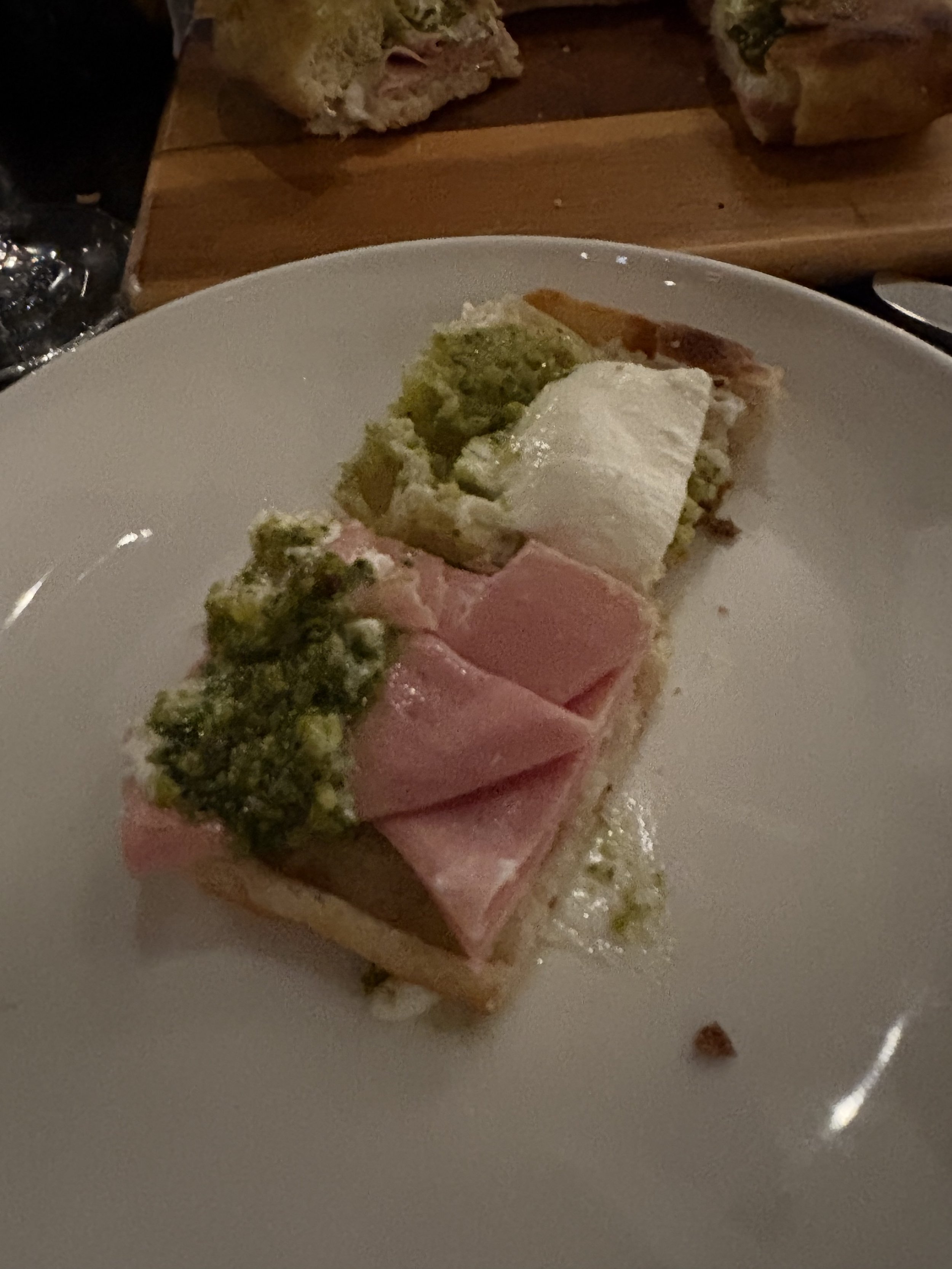Review: Il Carciofo is the Last Roman
Estimated reading time: 6 minutes (1200 words)
The West Loop has transformed itself at least twice in the past 25(!) years: first from the meatpacker district to the city’s “cool” destination, replete with innovative restaurants, luxury shopping, boutique hotels, and endless construction; and again from “cool” to… whatever it is now. In 2025, the West Loop is not “cool,” at least as it was pre-Covid, and can be more accurately described as an entirely Instagram-optimized neighborhood with a business base mostly (although not completely) supported by influencers and influencer wannabes.
I’ve made the argument before that the West Loop is over as Chicago’s innovative beating heart. Each new restaurant opening serves to drive the point home. With this backdrop in mind, I wanted to review Il Carciofo, celebrity chef and Chicago native Joe Flamm’s latest entry — and quite possibly the Last Roman of the West Loop’s culinary glory.
Flamm’s other restaurant*, Rose Mary, which opened in the midst of the pandemic in spring 2021, has clearly served as the forerunner for Il Carciofo (“The Artichoke” in Italian). Where Rose Mary is the culmination of personal influences, Il Carciofo is a more careful study of one singular cuisine: Roman. Not pan-Italian, as many Italian restaurants are, but specifically Roman dishes that are everywhere in the Eternal City.
[Read The New Chicagoan’s review of Rose Mary]
Il Carciofo’s menu incorporates these dishes, many of which would be at home at one of the numerous trattoria that dot Rome. From the antipasti section, my wife and I ordered the abbacchio (lamb) and the namesake carciofo, although classics such as suppli (surprisingly difficult to find around town), prosciutto, and puntarella were also listed. It should be noted that the menu is written entirely in Italian without the usual English hints about what a dish contains. This made ordering a little more adventurous than usual. Whether that is a good thing or a bad thing is up for diners to decide.
The appetizers came out quickly. The artichoke is a Roman classic, and Flamm’s version was executed flawlessly. The dish came with two small, fried artichokes which were seasoned lightly with salt. Otherwise the vegetable spoke for itself, and it was delicious. It shouldn’t be surprising that this restaurant’s namesake dish was arguably the best item of the night.
Left: abbacchio. Right: carciofi.
The lamb was excellent in a more unexpected way. Four small (about two ounces each) shanks were served, each cooked delicately so that the meat retained its shape but could be easily stripped from the bone. Underneath the shanks was a sauce made from vin santo, a Tuscan sweet wine that reduced into a thin syrup that wonderfully complimented the protein. A few needles of fresh rosemary were also included, which added a subtle herbal dimension that pulled the dish together. Despite the simplicity of the dish, it was packed with sweet, gentle flavors that served as an excellent starter.
From the pizza section, we ordered the mortadella, which was not so much of a pizza as a focaccia flatbread sandwich. This was also strikingly similar to a dish we had at a hole in the wall restaurant in the Tuscan countryside halfway between Florence and Rome when we visited last September.
In between bread slices was a spread of stracciatella, pistachio pesto, and mortadella, drizzled with some olive oil. Compared to the “real” version I tried in Italy, this one is a worthy imitation. The flavors were spot on, although the mortadella was sliced and layered too thick to maintain a proper balance between all the components. The focaccia was also a little problematic: unlike thick, fluffy focaccia bread that is commonplace at Italian restaurants, this one was thinner and crispier. The crispiness, especially, was off putting and detracted from the rest of the pizza/sandwich. But those were small issues, and the focaccia might be fine tuned once the restaurant finds its footing.
Left and middle: mortadella pizza from Il Carciofo. Right: mortadella pizza from a restaurant in Tuscany, Italy.
Pasta is the name of the game here. According to Eater, Il Carciofo built out a humidity controlled pasta development space, which is prominently on display at one end of the dining room near the bathrooms. Given that level of investment, both financial and square footage, the pasta should be exceptional. And for the most part, it is.
We tried the carbonara and tagliatelle dishes**, two staples of Italian dining and both that are fairly easy to make at home. The carbonara was the star: freshly extruded rigatoni was bathed in a golden sauce of egg yolks, guanciale fat, and cheese. Flamm’s version, probably refined from his time at Spiaggia (RIP) and Rose Mary, has a noticeably more yellow/gold sauce than most carbonaras, making for a slightly thicker coating while remaining creamy.
Carbonara is one of the most basic Italian dishes to cook yourself, which makes a $24 price tag a little difficult to justify. Additionally, the rigatoni in our dish was much too al dente for a restaurant of this caliber. But this carbonara otherwise hits the mark.
The tagliatelle was $28, but was easier to justify. The oxtail ragu it was served with was perfect, and unlike the carbonara, the pasta was precisely cooked al dente without going over or under. Both dishes were worth the price, but between the two, the tagliatelle was more worth the upcharge.
Left: tagliatelle. Right: carbonara.
Between two starters, two pastas, and a pizza, we saved just enough room for dessert. Like Rose Mary, Il Carciofo’s dessert menu is small but tailored. Sorbet, gelato, and “dolci” (pastries) are all represented. After a starch-heavy meal the only item that sounded good was the pistachio gelato, which our server described as an “old school” spread of ice cream. He was correct: what arrived at the table was one very large paddle-full of Green Giant-hued pistachio gelato.
For anyone with a sweet tooth this could serve as the highlight of the evening: the gelato was balanced between fluffy and chewy (almost mochi-like), and the pistachio flavor was pronounced without being overwhelming. Given the size of the dish it is best for sharing, and one serving will go a long way.
A final observation about Il Carciofo: the restaurant says of itself that “With rich layers of dark woods, plush fabrics, handmade tiles, warm natural stones, and deep saturated colors, our interior speaks to the history and tradition of age-old trattorias and ristorantes in Rome.”
This is not quite true, and worth noting as I felt that the interior design actually detracted somewhat from the overall experience. Il Carciofo is, to be frank, a boring spot with none of the personality or personal influence on display at Rose Mary. Everything is stripped down to the basics, from tables and chairs to a notable lack of artwork or decor. There is no here here, and in some ways, Il Carciofo feels like a dining no man's land. My wife described it succinctly: “it feels like it was designed by AI.”
These shortcomings are real. From the focaccia to raw pasta to a bland setting, Il Carciofo misses some of the high marks it set for itself, and which one day it will hopefully be capable of achieving. But with that said, and given the context it inserted itself into, Chicago’s latest Roman restaurant is worth an enthusiastic visit.
Details
Stars: Two (out of four)
Price: $$ 1/2 (out of four)
Style: Italian (Roman)
Atmosphere: Bland, dark, cold, moody
Location:
1045 W Fulton Street,
Chicago, IL 60607
Website:
https://www.ilcarciofochicago.com/
Star guide: one - poor, not worth time or money; two - mediocre, worth a visit on occasion; three - very good yet with issues; four - exceptional quality
Price guide: $ - cheap; $$ - affordable; $$$ - special occasion; $$$$ - rare opportunity
*Flamm is involved in the kitchen at BLVD on Randolph, but it’s not his concept or restaurant the way Rose Mary and Il Carciofo are.
**Il Carciofo’s menu contains three out of the four classic Roman pastas: cacio e pepe, carbonara, and amatriciana, but is notably missing pasta alla gricia. This seems like some low hanging fruit that would only benefit the menu if it was added.









